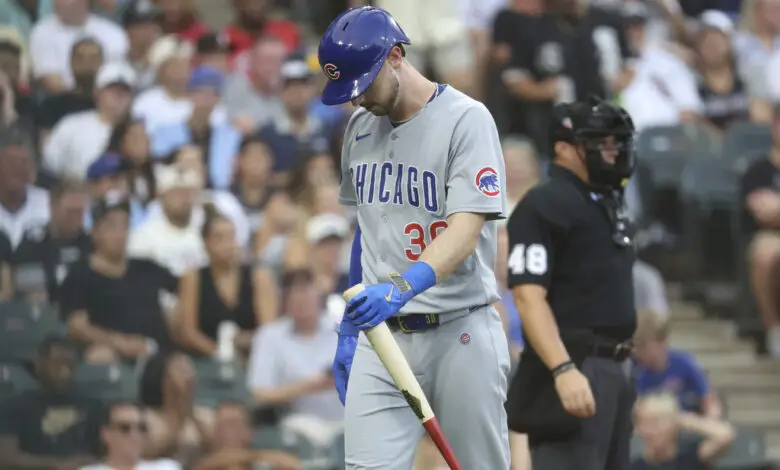
Kyle Tucker’s Downturn May Stem from Foul Ball to Knee
Ed. note: It was revealed late Wednesday that Tucker was apparently diagnosed with a slight fracture in his hand back in June. Great stuff, huh? And what awesome timing, just a few hours after I published this piece. While I still think the timing of the downturn tracks much more closely with something else, it’s entirely possible Tucker’s compensation for the hand just took a while to catch up.
The downturn in Kyle Tucker‘s performance has been obvious to anyone who’s seen him play, but the root of his ongoing slump remains nebulous. Most of the blame has been placed on the jammed finger he suffered in early June, something we’ve examined more than once in recent days (here and here). Jed Hoyer lent credence to that theory during a Monday appearance on 670 The Score’s Mully & Haugh Show.
“He probably changed his mechanics a bit while fighting through it,” Hoyer explained. “And I think that probably is a big part of it. I mean, he is a little bit different mechanically than he was at the beginning of the year, and that’s what he’s working hard to get back to.
“Clearly, he’s struggling; you can see it in his face, in his body language, how much he’s struggling. He’s such a natural hitter. For a guy like that to go through an extended stretch like this, I’m sure it’s one of the first times in his life he’s probably gone through this. It’s hard. Obviously, it’s a big year for him and he wants to help the team.”
I don’t doubt at all that Tucker wants to help both the team and himself, particularly when you consider what the nosedive in his numbers could mean for his pending free agency. But when it comes to the mechanics, something just wasn’t sitting right with me. It’s possible the finger thing was chronic enough to have a cumulative effect, but Tucker hurt it on June 1 and missed one game before proceeding to have his best month of the season.
After batting .279 with seven homers and a 156 wRC+ in March and April, Tucker hit .287 with five dingers and a 145 wRC+ in May. June saw him hit five more homers while batting .311 with a gaudy 173 wRC+ that had him looking every bit the part of a $500 million man. Then came July, which began with just one homer and a 77 wRC+ through 15 games. Playing in the All-Star Game meant getting precious little rest, so it could just be a matter of exhaustion.
Or maybe the cause of Tucker’s anemic numbers is similar to what caused him to miss most of last season. He was initially diagnosed with a shin contusion after fouling a ball off his leg on June 3, but it was later revealed that he’d suffered a small fracture. Tucker ended up missing a little over three months and coming back as good as ever down the stretch.
While I don’t believe any possible lingering issue is nearly as significant as that, Tucker fouled a ball off the inside of his right knee on July 22 against the Royals. He remained in the game — even stole home! — but was then given the next game off to allow him two days to rest before heading to the South Side.
Kyle Tucker fouled a ball off his right knee, but stayed in the game. pic.twitter.com/ald1YWRzcp
— Marquee Sports Network (@WatchMarquee) July 23, 2025
I want to acknowledge here that Tucker actually posted a 171 wRC+ over the remainder of the month, a span of 33 plate appearances, though that was mainly due to his .515 OBP in a limited sample. It’s possible his vaunted plate approach received a boost from him knowing his lower half wasn’t up to the rigors of legging out more hits, so he was being more patient out of necessity.
I had already been noodling on the idea of a lower-body issue after posting a thread on X breaking down Tucker’s broken-down swing based on a video shared by former CI stalwart Brendan Miller, now of CHGO. Then CI’s Jacob Zanolla texted me the tweet above, bringing something from the back of my head right to the forefront.
Kyle Tucker keeps grounding out.
Hoyer says it’s mechanics. Kelly points to the hand. Data says bat path/speed look normal over last 2 months.
Trying to make sense of it on ‘Cubs on Tuesday’ pod:
?Spotify: https://t.co/SU7GJg8hTe
?Apple: https://t.co/xpWuH6YxnP pic.twitter.com/9kgy6VHPKr
— Brendan Miller (@brendan_cubs) August 19, 2025
Miller noted (info in second link of opening paragraph) that Tucker’s bat speed and launch angle have been decreasing recently, which could be signs of fatigue. I had missed the loss of bat speed because I was using the finger injury as the inflection point. The right hand doesn’t drive the power of a left-handed swing anyway, and you can see in the video that Tucker appears to be bailing early with his lower half while failing to remain firm on his front side.
It also looks like he’s trying to generate a little extra coil, or hip-shoulder separation, by counter-rotating his back shoulder. That’s a classic symptom of overcompensating for fatigue or injury, and it could be entirely subconscious. To that end, everything Hoyer is saying above could be correct. Even if it’s the knee and not the finger, and even if any injury has cleared up, there could be residual mechanical issues preventing Tucker from getting right.
At the risk of upsetting anyone who doesn’t care for my personal anecdotes, the first thing I thought of when I saw the video above was my son’s left-handed swing when he’s tired. He’s about the same size as Tucker and swings nearly as hard, making similarities a little easier to spot. Hitting with weak or tired legs results in exaggerated upper-half movements meant to make up for the weaker base, which is what I see when watching Tucker over the last month or so.
In addition to his swing speed dropping from an average of 72.1 mph prior to the foul ball in question to 71.4 mph after, Tucker’s swing length has shortened ever so slightly. That might be an indication of the shoulder counter-rotation noted above replacing a legitimate stretch in the load, which may come from Tucker being less confident in landing firmly on that (potentially) injured right knee. That could still be happening even if the knee is fully recovered.
I’ll close with the fairly obvious caveats that my hypothesis is based almost exclusively on anecdotal evidence and might be colored by confirmation bias. That said, the eye test seems to be supported by publicly available data and relatively extensive personal experience. The good news is that Tucker’s struggles could be turned around with a little rest and targeted adjustments. It’s very difficult to make mechanical changes and almost impossible to get healthy without taking time off, so even a day or two here and there could be very beneficial.
And we haven’t even dug into the mental aspects of this whole thing, which could be at least as deleterious to production as the physical side. Regardless of the root causes and how they are addressed, getting Tucker back to something resembling his first-half performance puts the Cubs in a much better position for the remaining few weeks of the season.

